NHL News
2024-25 Opening Night Roster LTIR Projections
This article was originally published on Oct 2. It was updated Oct 3 to reflect the news that Robin Lehner's cap hit is removed from Vegas.
Projecting how teams will set their roster to best utilize LTIR
Welcome to the annual PuckPedia LTIR prediction article, where we attempt to predict how teams will set their rosters up for the NHL’s opening roster submission to optimize LTIR and their cap space.
Last season set yet another new record with 22 teams placing players on long-term injured reserve (LTIR). That beat the previous record, which was set the previous season, of 19 teams (before that the record was 16 NHL teams).
LTIR will be a popular topic over the coming days as it will factor in heavily as clubs manipulate their rosters and cap sheets ahead of the Oct 7 opening roster submission.
LTIR is one of the most cited, impactful, and yet misunderstood acronyms in the NHL’s salary cap era.
But first, a quick refresher on how LTIR works…
What is LTIR?
When a player is injured and expected to miss at least 10 NHL games AND 24 days of the NHL regular season, they are eligible for placement on LTIR. While a player is on LTIR, their team may exceed the salary cap.
Despite the common misconception, a player on LTIR does not have their cap hit removed from the team’s cap total. LTIR allows the team to potentially exceed the cap by an amount commonly referred to as the “LTIR Pool.”
How much can the LTIR team exceed the cap?
There are two methods for determining a team’s LTIR Pool, which is how much they can exceed the cap.
1. If a team is under the cap prior to placing the player on LTIR, then the LTIR pool is the injured player’s cap hit minus the team cap space available at the time. For example, if a player with a $4 million cap hit goes on LTIR, and their team has $100,000 of cap space, the team’s LTIR pool would be $3.9 million ($4,000,000-$100,000). Because of this, teams often make several roster moves right before a player goes on LTIR to be as close to the cap as possible to maximize their LTIR Pool.
2. If a team is over the league’s $88 million cap when they submit their opening roster, their LTIR pool would be the amount they exceed the cap. For example, if a team is $3 million over the cap and places a player on LTIR with a $4 million cap hit, their LTIR Pool would be the $3 million they exceed the cap. Once this method is used, the team starts the season with $0 cap space until more roster moves are made.
This is why a potential LTIR team tries to be as close as possible to the cap ceiling (method 1) or be over the cap by an amount close to the injured player’s cap hit (method 2) for their opening roster submission.
Once a team’s initial LTIR pool is established, any additional players going on LTIR throughout the season have their cap hit added to the existing LTIR pool.
Consequences of using LTIR
While using LTIR allows a team to exceed the cap, there are some negative consequences of being an LTIR team:
- LTIR teams do not accrue cap space during the year. If a team has $1 million of space available in their LTIR pool on Day 10 of the season, assuming no other roster moves, they will still have only $1M of space available at the trade deadline. For non-LTIR teams, $1 million of projected cap space on Day 10 of the season would allow them to add a player with a $4.5 million cap hit at the trade deadline.
- By definition, a team using LTIR all-season would finish the year with a final cap hit greater than the salary cap. Consequently, any performance bonuses earned by players on that team during the season are carried over and added to that team’s cap hit for the following season. A total of 12 teams have performances bonus overages from 2023-2024 on their 2024-2025 cap ( 15 teams had performance bonus overages from 2022-23 on their 2023-24 cap.
Potential LTIR teams to start 2024-25
Currently, there are at least 3 teams poised to use LTIR to open the season.
Here’s a closer look at each of them, including some potential ways they can optimize LTIR.
Check out this overview of Season Opening Injured Reserve (SOIR).
Washington Capitals
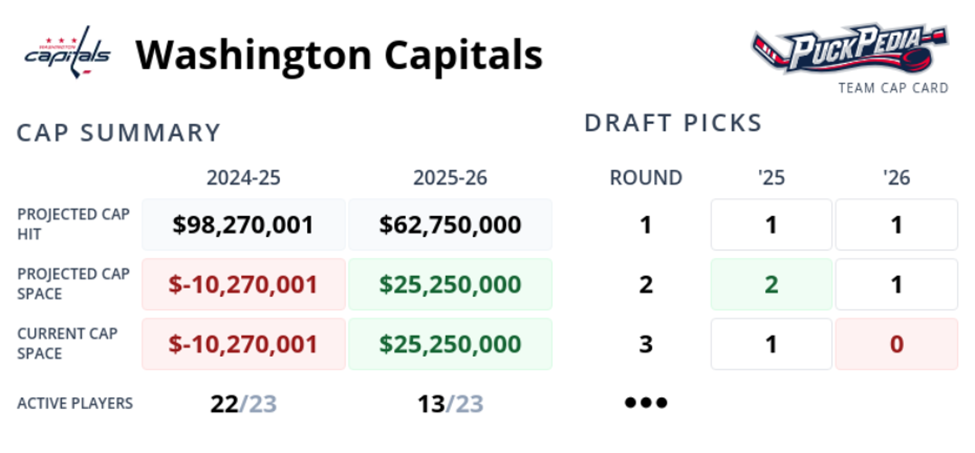
Projected Roster as of Oct 2 on PuckPedia.com
LTIR candidates: Nicklas Backstrom ($9.2M), TJ Oshie ($5.75M)
LTIR moves: Washington utilized off-season LTIR with Backstrom on LTIR, so they must include him on LTIR in their opening roster submission. The current projected roster of 22 healthy players is $10.27M over the cap, which is $1.07M more than Backstrom’s Cap Hit. Therefore, to be cap compliant, they would have to also add Oshie to LTIR for the opening submission. However, even if they add a 23rd player, they would be about $11.3M over the cap, which is still $3.65M away from optimizing LTIR for both Backstrom & Oshie on LTIR (combined $14.95M).
Therefore, the most optimal path is to submit a roster that is less than $9.2M (Backstrom) over the cap, and then subsequently add Oshie to LTIR. To clear that $1.07M additional cap hit, they could send down waiver exempt Lapierre ($863K) and another low cap hit player who needs waivers (like Alexeyev). Or, since they need to risk someone on waivers anyways, they could waive and send someone down with a cap hit of $1.07M or more. Some candidates could be Ethan Bear, Sonny Milano, or Brandon Duhaime. Sending any of these players would clear $1.15M (the burying threshold this year). This puts Washington $9.12M over the cap, which is just $80K less than Backstrom and an optimal LTIR capture.
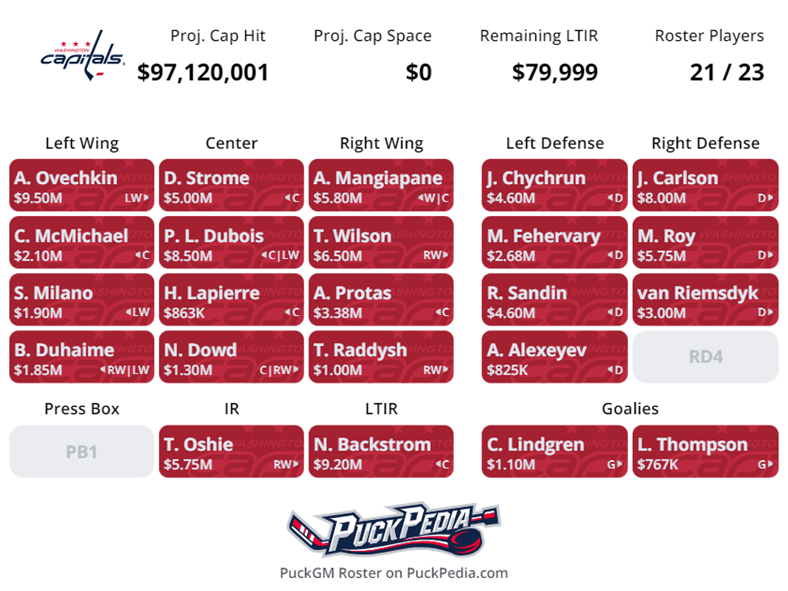
Potential opening roster submission with a player with Cap Hit $1.15M or more (Bear in this example) waived & sent down
In the example below, Ethan Bear is the player waived and sent down. After the opening roster submission, Washington could add Oshie to LTIR and gain $5.75M of cap space, which would then allow the player sent down (Bear in this example) to be called back up.
Vegas Golden Knights
LTIR candidates: Lehner ($5M)
On October 3, Frank Seravalli and Elliotte Friedman reported that a settlement had been reached between Robin Lehner, Vegas, and the NHLPA. Lehner failed to report for his physical, which normally would be grounds for either suspension without pay or contract termination. Due to his unique circumstances, a settlement was reached where his contract is removed from Vegas, and he still receives the compensation owing. As a result, Vegas will not start the year in LTIR.
Montreal Canadiens
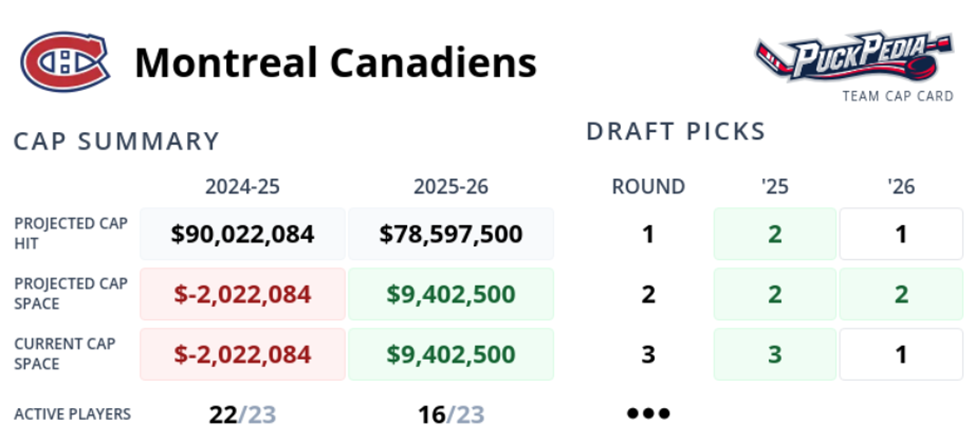
Projected Roster as of Oct 2 on PuckPedia.com
LTIR candidates: Price ($10.5 million), Laine ($8.7M), Harvey-Pinard ($1.1M)
LTIR moves: The current roster is $2.02M over the cap. If they put Laine on LTIR to start, they’re wasting $6.7M potential space space. Perhaps that doesn’t matter when subsequently adding Price to LTIR adds $10.5M of space, but it is still less than ideal. The best way to optimize LTIR would be for Montreal to be over the cap by just less than Harvey-Pinard’s $1.1M Cap Hit. They would then get a capture closer to optimal and could subsequently add Price ($10.5M) and Laine ($8.7M) and add their cap hits as cap space.
This means Montreal would need to reduce the team cap hit by $922K or more, and they have lots of options for this. They could send down waiver exempt Hutson ($950K), Slafkovsky ($950K) or Xhekaj ($1.15M cap savings). They could also waive someone like Armia. The downside of sending Hutson down would be when called back up he would use up $1.33M of Cap Hit due to his performance bonuses, but that’s a drop in the bucket compared to the additional $10.5M space gained with Price on LTIR. Therefore, sending Xhekaj down for the opening roster submission would result in a less optimal initial LTIR capture, but yield more cap subsequent cap space since Hutson would then only count $950K against the cap.
With Hutson down, Montreal is $1.072M over the cap, within $28K of the optimal capture with Harvey-Pinard on LTIR. They could subsequently add Price to LTIR and call Hutson back up and have $9.1M of cap space even without putting Laine on LTIR.
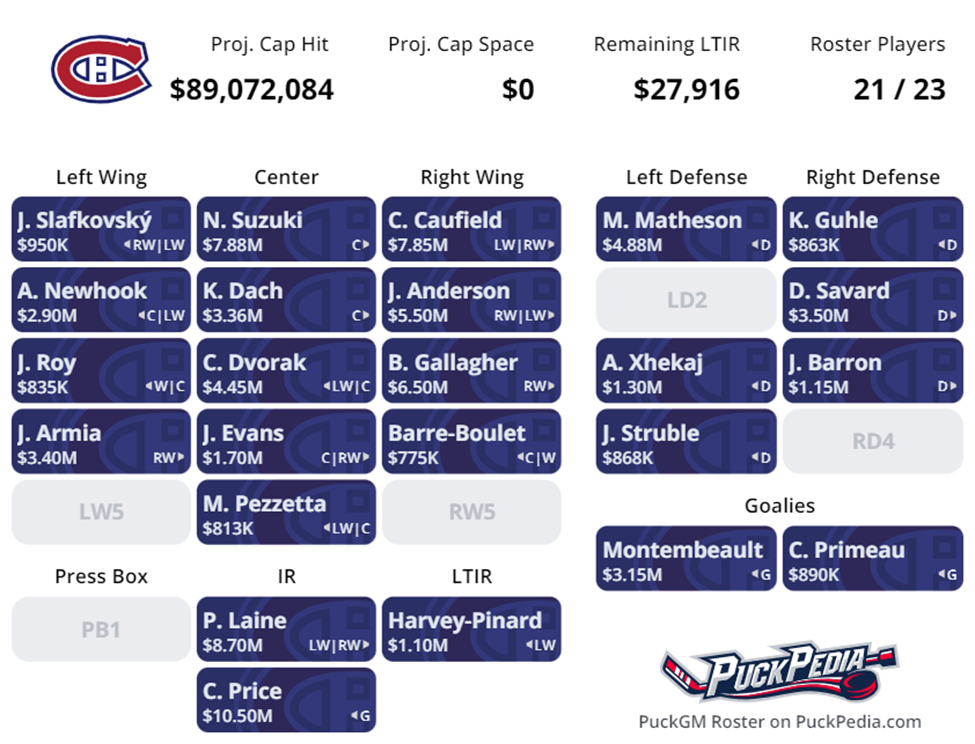
Potential opening roster submission starting with just Harvey-Pinard on LTIR & sending a player with a cap hit of $922K or more down (Hutson in example)
Toronto Maple Leafs
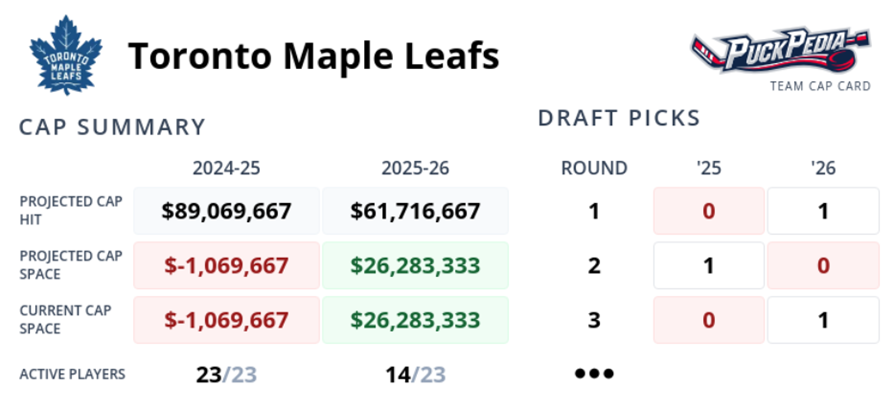
Projected Roster as of Oct 2 on PuckPedia.com
LTIR candidates: Dewar ($1.18M), Hakanpaa ($1.47M)
Players to sign: Pacioretty, Lorentz
LTIR moves: Toronto has so many options and balls in the air that the exact moves are very difficult to predict. The most obvious potential path is waiving and sending down Timmins, which puts them $30K under the cap with 20 healthy players + Dewar & Hakanpaa and no contracts yet for Pacioretty and Lorentz. They could then add both players to LTIR, giving them $2.62M cap space ($1.18M + $1.47M - $30K), and then sign Pacioretty and Lorentz to contracts that are less than that space.
Similarly, but alternatively, they could sign one or both players prior to the opening roster and start with one or both of Dewar and Hakanpaa on LTIR.
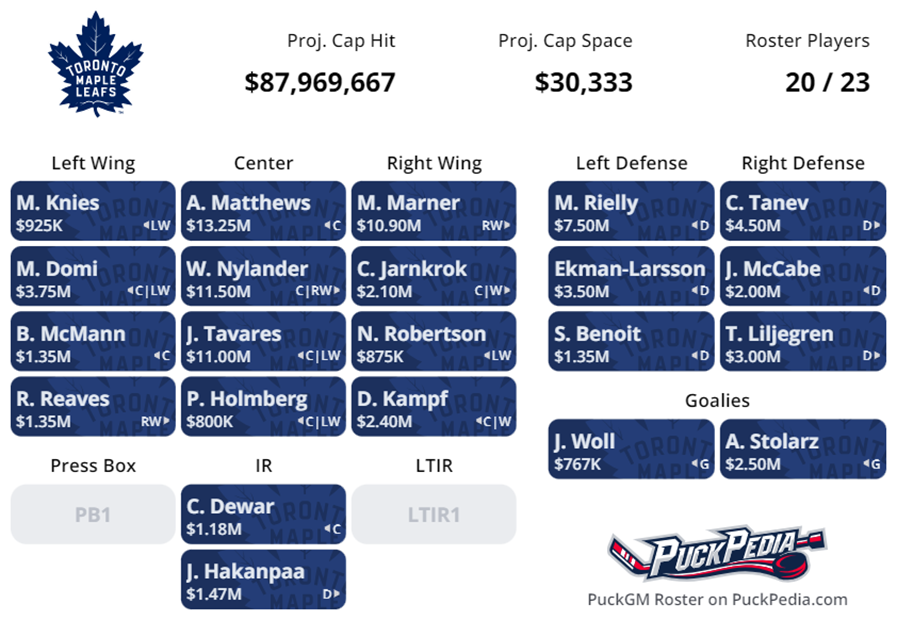
Potential opening roster submission starting with Timmins waived/sent down, nobody on LTIR & no new contracts
Honourable mentions:
Pittsburgh Penguins – With Nieto ($900K) out for the season, they could potentially use LTIR. Needing to use it depends on short-term injuries to Nedeljkovic, Lizotte, and Karlsson. If they need to carry a 3rd goalie due to Nedeljkovic being out, they could stay under the cap by waiving forwards like Puljujarvi and Bemstrom. If they want to use LTIR, they could waive and send down Bemstrom and replace him with MacArthur. That roster is $897K over the cap, within $3K of the optimal LTIR capture if Nieto starts on LTIR.
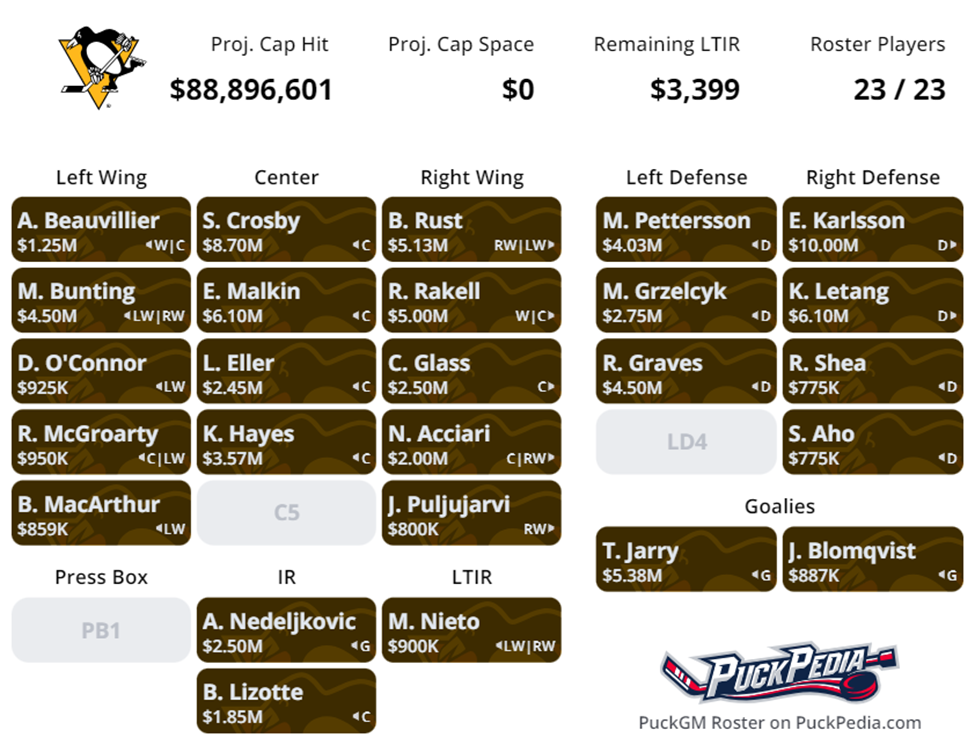
Potential opening roster submission if Nieto begins on LTIR, with Bemstrom down & MacArthur up
Carolina Hurricanes – They have $80K projected Cap Space and Fast ($2.4M) out for the year. They could add Fast to LTIR after the opening roster submission and have a pretty optimal LTIR capture.
Vancouver Canucks – They have $91K Projected Cap Space with 22 players on the roster (including Demko as a 3rd Goalie) with Joshua ($3.25M) and Poolman ($2.5M) as LTIR options. They could submit close to the cap and subsequently add one or both players to LTIR optimally.
New Jersey Devils – Luke Hughes is expected to miss a few weeks and Pesce is set to miss the start of the season. The projected roster has $976K of cap space with 21 healthy players. Considering they’ll have some time off following their Europe trip, they likely would start the season under the cap and wait to determine if they need LTIR.
Edmonton Oilers - Evander Kane is an LTIR candidate, but the Oilers have publicly stated their desire to start the year under the cap and try to accrue space. It would be unlikely for them to place Kane on LTIR unless they suffer multiple injuries.
St. Louis Blues – Krug is out for the year so he is a potential LTIR candidate, but they have over $1M of projected cap space with a full 23-player active roster, so barring a trade it’s unlikely they would start the season in LTIR
In addition to the 4 teams likely to start the season in LTIR, another 13 teams project to have less than $1,000,000 of cap space. That means if injuries hit, we could expect many of these teams to also enter LTIR at some point.
Watch for the teams making roster moves through the Oct 7 roster submission and see the final rosters on PuckPedia.com.








